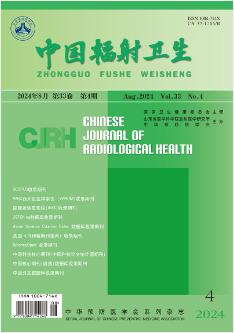The measurement method of gamma ray air absorbed dose rate based on LaBr 3 (Ce) detector
引用次数: 0
Abstract
Objective Based on the lanthanum bromide scintillator detector, the calculation method of G( E) function was developed to measure the air absorbed dose rate. Methods Firstly, the gamma energy spectrumof the lanthanum bromide detector were simulated and the response functions with different energies were determined with Monte Carlo simulation method. Then, the G( E) function was calculated by the least square method. Finally, the air absorbed dose rate measured by the lanthanum bromide detector using G( E) function conversion method was compared with the theoretical calculation value based on the point source experiments. Results The experimental verification results showed that the relative deviation between thecalculated value with G( E) function and the theoretical calculation value wasmostly controlled within ± 6%, which verified the accuracy of G( E) function. Conclusion The results showed that the method of G( E) function could be applied to calculate the gamma radiation dose rate based on the in-situ the gamma spectrum with LaBr 3 detector. 摘要: 目的 针对溴化镧闪烁体探测器, 开展了 G( E) 函数的计算方法研宄, 最终实现了空气吸收剂量率的测量。 方法 首先, 基于蒙特卡罗模拟计算方法, 模拟计算出溴化镧探测器的 γ 能谱, 给出不同能量的响应函数;然后, 利用 最小二乘法计算得到了 G( E) 函数;最后, 利用标准点源实验, 将溴化镧探测器利用 G( E) 函数转换测量得到的空气吸 收剂量率与理论计算值进行了比较。 结果 实验验证结果表明, 基于 G( E) 函数得到的空气吸收剂量率与理论计算值 的相对偏差控制在 ± 6% 以内, 验证了 G( E) 函数的准确性。 结论 基于 γ 谱-剂量转换方法, 就地 γ 谱仪可应用于辐射 剂量的测量。基于LaBr3(Ce)探测器的γ射线空气吸收剂量率测量方法
Objective Based on the lanthanum bromide scintillator detector, the calculation method of G (E) function was developed to measure the air absorbed dose rate Methods First, the gamma energy spectrum of the lanthanum bromide detector was simulated and the response functions with different energies were determined with Monte Carlo simulation method Then, the G (E) function was calculated by the least square method Finally, the air borne do rate measured by the lanthanum bromide detector using G (E) function conversion method was compared with the theoretical calculation value based on the point source experiments Results The experimental verification results were shown that the relative deviation between the calculated value with G (E) function and the theoretical calculation value was controlled within ± 6%, which verified the accuracy of G (E) function Conclusion The results showed that the method of G (E) function could be applied to calculate the gamma radiation dose rate based on the in situ gamma spectrum with LaBr 3 detector Abstract: A study was conducted on the calculation method of G (E) function for lanthanum bromide scintillator detectors, ultimately achieving the measurement of air absorbed dose rate. Firstly, based on the Monte Carlo simulation calculation method, the performance of the lanthanum bromide detector is simulated and calculated γ Energy spectrum, providing response functions for different energies; Then, the G (E) function was calculated using the least squares method; Finally, using standard point source experiments, the air absorbed dose rate measured by the lanthanum bromide detector using G (E) function conversion was compared with the theoretical calculated value. The experimental verification results show that the relative deviation between the air absorbed dose rate obtained based on the G (E) function and the theoretical calculation value is controlled within ± 6%, which verifies the accuracy of the G (E) function. Conclusion based on γ Spectral dose conversion method, in situ γ Spectrometers can be used for measuring radiation dose.
本文章由计算机程序翻译,如有差异,请以英文原文为准。
求助全文
约1分钟内获得全文
求助全文
来源期刊
CiteScore
0.80
自引率
0.00%
发文量
7142
期刊介绍:
Chinese Journal of Radiological Health is one of the Source Journals for Chinese Scientific and Technical Papers and Citations and belongs to the series published by Chinese Preventive Medicine Association (CPMA). It is a national academic journal supervised by National Health Commission of the People’s Republic of China and co-sponsored by Institute of Radiation Medicine, Shandong Academy of Medical Sciences and CPMA, and is a professional academic journal publishing research findings and management experience in the field of radiological health, issued to the public in China and abroad. Under the guidance of the Communist Party of China and the national press and publication policies, the Journal actively publicizes the guidelines and policies of the Party and the state on health work, promotes the implementation of relevant laws, regulations and standards, and timely reports new achievements, new information, new methods and new products in the specialty, with the aim of organizing and promoting the academic communication of radiological health in China and improving the academic level of the specialty, and for the purpose of protecting the health of radiation workers and the public while promoting the extensive use of radioisotopes and radiation devices in the national economy. The main columns include Original Articles, Expert Comments, Experience Exchange, Standards and Guidelines, and Review Articles.

 求助内容:
求助内容: 应助结果提醒方式:
应助结果提醒方式:


